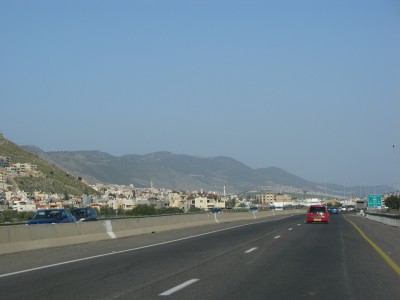 Pint-sized Israel – a country about the size of New Jersey – packs in a lot of geographic punch. I was determined this go-round to see more of what had eluded me on previous travels. With my rental car at last secured, I headed northward on Israel’s spotless, gleaming Highway 6. As the country’s easternmost north-south thoroughfare, it bore reminders of the nation’s agonies: hillside towns with minareted mosques popped up here and again… only to be foregrounded by the nation’s security barrier; signage at off-ramps indicated routes to Israeli settlements.
Pint-sized Israel – a country about the size of New Jersey – packs in a lot of geographic punch. I was determined this go-round to see more of what had eluded me on previous travels. With my rental car at last secured, I headed northward on Israel’s spotless, gleaming Highway 6. As the country’s easternmost north-south thoroughfare, it bore reminders of the nation’s agonies: hillside towns with minareted mosques popped up here and again… only to be foregrounded by the nation’s security barrier; signage at off-ramps indicated routes to Israeli settlements.
As I drove, the landscape grew hilly yet more verdant than the rocky mountainscapes down south. Passing slopes covered in white-stone apartment blocks, I followed my GPS’s directions and arrived at my accommodations on the slopes of Haifa’s Mount Carmel just as the sun was setting over Haifa Bay.
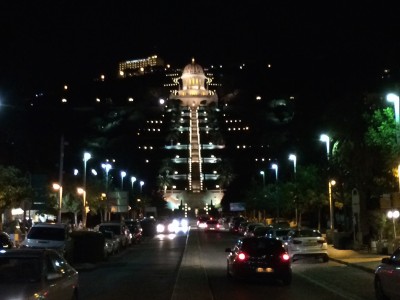 I’ve long been captivated by Haifa, in the abstract at least, for a topographic feature it shares with Hong Kong: both urban centers sit astride the slopes of mountains. Alas, it became clear when I arrived that both cities share something else: aside from their stellar geography, neither offers much to write home about aesthetically. In Haifa’s case, curvy mountain roads are fronted by dirty, forgettable apartment blocks. Oh, sure, there’s the odd gem – my hotel, located in an elegant former mansion, was one; the road at the foot of the mountain bearing old stone edifices of the city’s German Colony (where I had a nice dinner of schnitzel, natch) is another. And, of course, the sea and sky and – on the night I was there – a glorious full moon overlooking twinkling Haifa Bay. Echoes of Valparaíso, Chile, or my current hometown of San Francisco, came to mind as I wandered up and down gritty streets amid pleasant breezes.
I’ve long been captivated by Haifa, in the abstract at least, for a topographic feature it shares with Hong Kong: both urban centers sit astride the slopes of mountains. Alas, it became clear when I arrived that both cities share something else: aside from their stellar geography, neither offers much to write home about aesthetically. In Haifa’s case, curvy mountain roads are fronted by dirty, forgettable apartment blocks. Oh, sure, there’s the odd gem – my hotel, located in an elegant former mansion, was one; the road at the foot of the mountain bearing old stone edifices of the city’s German Colony (where I had a nice dinner of schnitzel, natch) is another. And, of course, the sea and sky and – on the night I was there – a glorious full moon overlooking twinkling Haifa Bay. Echoes of Valparaíso, Chile, or my current hometown of San Francisco, came to mind as I wandered up and down gritty streets amid pleasant breezes.
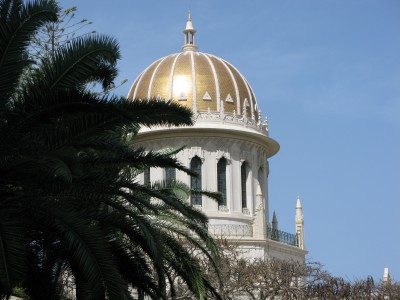 Haifa’s main attraction was my first destination the next morning: the Bahá’í World Centre, a sprawling campus of gorgeous, immaculately-manicured gardens and buildings climbing Mount Carmel above the German Colony. The Bahá’í are an interesting lot, a blend of proto-hippie pacifism and traditional theism that originated in Persia in the 19th century. Their holy sites are positively magnificent the world over, from Wilmette, Illinois; to New Delhi, India; to here, in the land where so many religions claim as their home. I may not be one for spirituality or faith, but I sure can appreciate tranquility and great architecture.
Haifa’s main attraction was my first destination the next morning: the Bahá’í World Centre, a sprawling campus of gorgeous, immaculately-manicured gardens and buildings climbing Mount Carmel above the German Colony. The Bahá’í are an interesting lot, a blend of proto-hippie pacifism and traditional theism that originated in Persia in the 19th century. Their holy sites are positively magnificent the world over, from Wilmette, Illinois; to New Delhi, India; to here, in the land where so many religions claim as their home. I may not be one for spirituality or faith, but I sure can appreciate tranquility and great architecture.
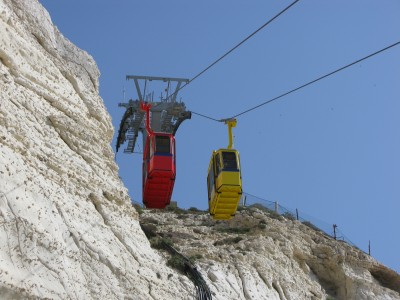 From there, I piloted my little Chevy Spark northward, to coastal Israel’s topmost point, and the site of one of my earliest travel memories: the grottoes of Rosh HaNikra.
From there, I piloted my little Chevy Spark northward, to coastal Israel’s topmost point, and the site of one of my earliest travel memories: the grottoes of Rosh HaNikra.
This spot stands out in my mind for two reasons: one, the astounding, glorious interplay of sea and rock, as the waters of the Mediterranean pound against the grottoes of the chalk cliffs; two, for the cable car – I had a bit of a childhood fixation on them – that’s apparently the steepest in the world. Together with gaggles of mostly Israeli tourists and their families (the place remains an attraction for all ages), I descended to the base of the cliffs. Both the cableway and the grottoes were smaller than I remembered, but the effect was no less enchanting.
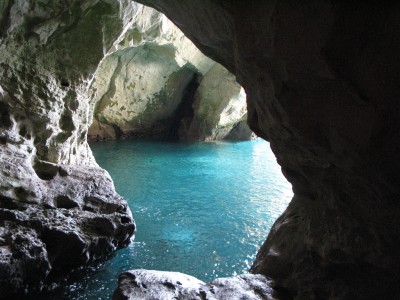 Equally haunting, and a bit sad, are the old railway tunnels dug by the British during Palestine’s Mandatory Period. Given the strategic vulnerability of tunnels from the north, toward Lebanon just on the other side of the rock, portions of these were blown up during Israel’s War of Independence in 1947-48. A quick swipe up from Google Maps revealed it: I was mere yards from Lebanon, and barely eighty or so miles from Beirut. Perhaps one day, in a different geopolitical climate, these tunnels will be reopened, and we travelers will again be able to ride the rails north up this glorious coast.
Equally haunting, and a bit sad, are the old railway tunnels dug by the British during Palestine’s Mandatory Period. Given the strategic vulnerability of tunnels from the north, toward Lebanon just on the other side of the rock, portions of these were blown up during Israel’s War of Independence in 1947-48. A quick swipe up from Google Maps revealed it: I was mere yards from Lebanon, and barely eighty or so miles from Beirut. Perhaps one day, in a different geopolitical climate, these tunnels will be reopened, and we travelers will again be able to ride the rails north up this glorious coast.
After lunch and a seaside stroll in nearby Nahariya – a town whose proximity to Lebanon has rendered it susceptible to periodic shelling – I drove east, into the hills of the Galilee. The landscape was at once familiar – blink and it could be California’s Central Coast – and different – periodic Israeli and Palestinian towns offered up more minarets and red-tile roofs. As I crested one hill and began my descent, I saw a surprising road sign: “Sea Level.” I was almost to the Kinnereth, the Sea of Galilee, and my destination for that evening.
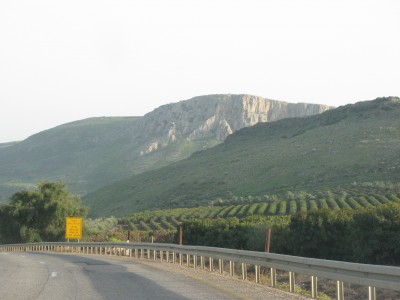 The Dead Sea gets all the glory for being the lowest spot on Earth, but it’s not the only place around here to bear the below-sea-level distinction. Starting around the Kinnereth and continuing south, this terrestrial depression is known as the Jordan Rift Valley. Depending on how you measure it, this geographic formation continues for thousands of miles into Africa toward the birthplace of humankind.
The Dead Sea gets all the glory for being the lowest spot on Earth, but it’s not the only place around here to bear the below-sea-level distinction. Starting around the Kinnereth and continuing south, this terrestrial depression is known as the Jordan Rift Valley. Depending on how you measure it, this geographic formation continues for thousands of miles into Africa toward the birthplace of humankind.
For me, however, the attachment held more recent origins: I checked in at the Galei Kinnereth Hotel, an old warhorse of a resort going back to the 1940s. Humbler and more faded than some newer resorts nearby, the place nonetheless holds a rich history: a small gallery on its second floor revealed images of Danny Kaye, Golda Meir, and David Ben-Gurion as past visitors.
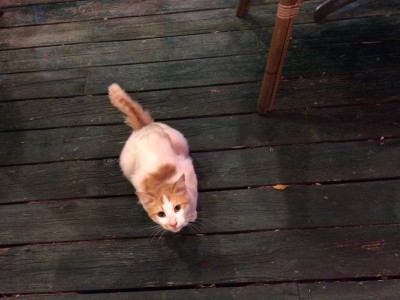 While dining at a lakefront eatery on some St. Peter’s Fish (a local variety of tilapia caught from the lake), a visitor to my table brought back memories of the present: a cat, one of Israel’s many that I’ve seen in my time here, watched me eat with those big, mournful eyes. Oh, I probably shouldn’t have, but I tossed the creature a bit of my meal, which she promptly scampered off to scarf down before returning to seek out another gullible tourist.
While dining at a lakefront eatery on some St. Peter’s Fish (a local variety of tilapia caught from the lake), a visitor to my table brought back memories of the present: a cat, one of Israel’s many that I’ve seen in my time here, watched me eat with those big, mournful eyes. Oh, I probably shouldn’t have, but I tossed the creature a bit of my meal, which she promptly scampered off to scarf down before returning to seek out another gullible tourist.
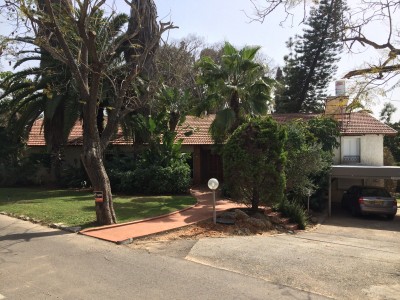 I headed back southward the next day, but before returning my rental car I made one final stop: driving through Savyon, a leafy neighborhood of low-slung homes, I reached it: a rambling ranch-style place where we lived during the three years in this land when I was a boy. A memory burbled up of loading up our Volvo station wagon for yet another adventure… and it was then that I realized what this weekend of driving was all about. It was here, in this diverse, Mediterranean land, that my passion for travel was ignited. These mountains, these lakes and beaches and cliffs and seas, all fired up my boyhood imagination, led me to inhabit a continent, and eventually explore the world. All great journeys have their beginnings, and for me, this was the place where wanderlust was born.
I headed back southward the next day, but before returning my rental car I made one final stop: driving through Savyon, a leafy neighborhood of low-slung homes, I reached it: a rambling ranch-style place where we lived during the three years in this land when I was a boy. A memory burbled up of loading up our Volvo station wagon for yet another adventure… and it was then that I realized what this weekend of driving was all about. It was here, in this diverse, Mediterranean land, that my passion for travel was ignited. These mountains, these lakes and beaches and cliffs and seas, all fired up my boyhood imagination, led me to inhabit a continent, and eventually explore the world. All great journeys have their beginnings, and for me, this was the place where wanderlust was born.
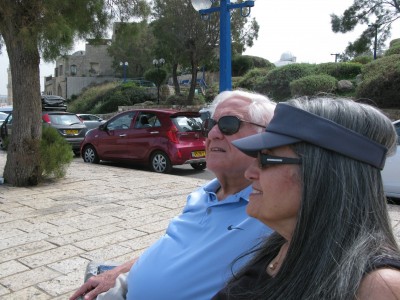 My finale in this land mirrored its opener on my previous trip: a sojourn in the country’s biggest city, Tel Aviv. I reunited with my Mom and Arthur for a dinner with my aunt and uncle, the parents of the newlywed groom who all live in the farming community down south. They’ve had a rough few years since my big world travels, including a traumatic falling-out with a religious community and nonprofit foundation they were involved in. But all that’s behind them now, and they seem happier than I’ve ever known them. Part of it might be their response to the interminable political turmoil of this little nation. As my aunt Ella put it:
My finale in this land mirrored its opener on my previous trip: a sojourn in the country’s biggest city, Tel Aviv. I reunited with my Mom and Arthur for a dinner with my aunt and uncle, the parents of the newlywed groom who all live in the farming community down south. They’ve had a rough few years since my big world travels, including a traumatic falling-out with a religious community and nonprofit foundation they were involved in. But all that’s behind them now, and they seem happier than I’ve ever known them. Part of it might be their response to the interminable political turmoil of this little nation. As my aunt Ella put it:
“We don’t watch the news anymore. It’s too depressing!”
Probably for the best.
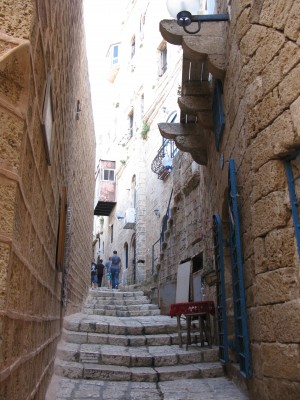 I didn’t quite make it to Old Jaffa, the ancient port city adjacent to modern Tel Aviv, on my last outing, so this trip gave me an opportunity to fill that in, too. But this time, I got to see it through the eyes of a former native: my Mom.
I didn’t quite make it to Old Jaffa, the ancient port city adjacent to modern Tel Aviv, on my last outing, so this trip gave me an opportunity to fill that in, too. But this time, I got to see it through the eyes of a former native: my Mom.
“It was a total slum until they fixed it up in the sixties,” she said as we strolled through spotless medieval stone alleyways that echoed my visit to Mdina in Malta last year. Unlike flat Tel Aviv, Jaffa sits on a small promontory that made it a prime location for a harbor. It was a warm, hazy spring day, and a set of rocks just offshore foamed up the blue seas: they’re said to be the legendary spot where Andromeda was rescued by Perseus in Greek myths (I was a bit obsessed with the original Clash of the Titans when I was a boy).
A lunch and a dinner and a few meetups with more relatives rounded out our time in Tel Aviv. Between both sides of my family it’s truly dazzling how many relations I have in this country – more than almost anywhere else on Earth. Strolling southward down the waterfront from the Port of Tel Aviv with two of my cousins the night before I left, I concluded that, yes, if I ever were to make this country my home, bustling, cosmopolitan Tel Aviv would be the place. For me, though, the country holds a sacredness that goes beyond cities or lifestyles or work or religion itself.
It’s the place where I learned to love travel.
Tags: 1 Comment





Your father was the inspiration for all those trips in the whitel Volvo…he loved the land and he loved to travel its highways and byways. I was the quartermaster general in charge of the
Logistics involved in schlepping three children under the age of seven (plus one dog), to pretty much every dig and historic site. Wonderful memories and a wonderful legacy…